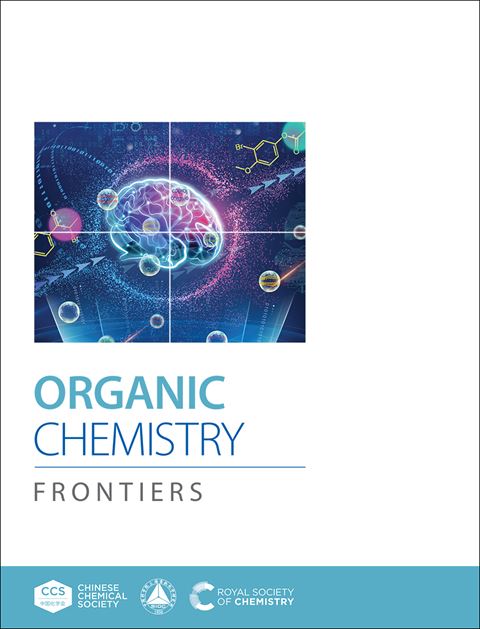光激活单电子还原法对瞬态丙二酸芳基芳基的研究:在咪唑啉酮丙二酸无催化剂多组分合成中的应用
IF 4.7
1区 化学
Q1 CHEMISTRY, ORGANIC
引用次数: 0
摘要
Meldrum的酸基多组分反应已经成为一种高度通用和有价值的工具,提供了一种简单的方法来获取许多具有药用和工业价值的杂环和无环有机化合物。这些反应绝大多数使用羰基化合物作为试剂之一,并利用瞬态丙二酸芳基的亲电活性。这必然需要第三种亲核试剂,并代表了这些反应的一般限制。在此,我们提出了通过可见光驱动SET/PT序列对丙二酸芳基芳基进行反应性测定的方法,该方法使Meldrum酸基mcr中的自由基化学成为可能。提出的方法的可行性证明了三组分合成迄今未知的咪唑啉酮丙二酸。通过力学实验和密度泛函计算证实了自由基链机理的存在。本文章由计算机程序翻译,如有差异,请以英文原文为准。
An umpolung of transient arylidene malonates via photoactivated one-electron reduction: the application to the catalyst-free multicomponent synthesis of imidazolinone malonic acids
The Meldrum’s acid-based multi-component reactions have emerged as a highly versatile and valuable tool, offering a simple access to numerous classes of pharmaceutically and industrially valuable heterocyclic and acyclic organic compounds. The vast majority of these reactions employ a carbonyl compound as one of reagents and utilize the electrophilic reactivity of transient arylidene malonates. This necessarily requires a third nucleophilic reagent and represents the general limitation of these reactions. Herein we propose the approach to a reactivity umpolung of arylidene malonates via visible light-driven SET/PT sequence, which enables the radical chemistry in Meldrum’s acid-based MCRs. The viability of the proposed approach is demonstrated by the three-component synthesis of hitherto unknown imidazolinone malonic acids. The radical chain mechanism is evidenced for the disclosed transformation by mechanistic experiments and density functional calculations.
求助全文
通过发布文献求助,成功后即可免费获取论文全文。
去求助
来源期刊

Organic Chemistry Frontiers
CHEMISTRY, ORGANIC-
CiteScore
7.90
自引率
11.10%
发文量
686
审稿时长
1 months
期刊介绍:
Organic Chemistry Frontiers is an esteemed journal that publishes high-quality research across the field of organic chemistry. It places a significant emphasis on studies that contribute substantially to the field by introducing new or significantly improved protocols and methodologies. The journal covers a wide array of topics which include, but are not limited to, organic synthesis, the development of synthetic methodologies, catalysis, natural products, functional organic materials, supramolecular and macromolecular chemistry, as well as physical and computational organic chemistry.
 求助内容:
求助内容: 应助结果提醒方式:
应助结果提醒方式:


